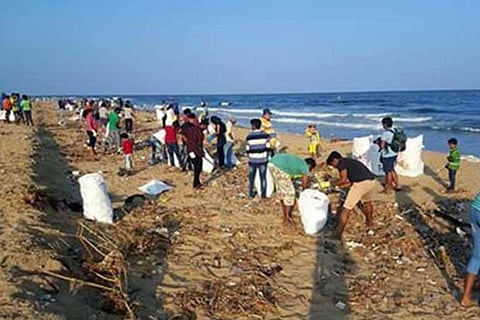

Chennai
The city, ranked 45 in last year’s survey, has inched past Coimbatore and Madurai that were ranked 46th and 47th, respectively, in the all-India report that encompasses major cities (with over 10 lakh people) and small cities (with under 10 lakh people). While Indore retained the tag of the cleanest urban local body (ULB), the New Delhi Municipal Corporation was judged as the cleanest city in the 1-10 lakh population category. The rankings were released a day after World Toilet Day was observed last Friday. The national cleanliness survey was launched in 2016 as part of the Swachh Bharat Abhiyan, aimed at cleaning up India and making it an open defecation-free nation. It’s a tall order, considering the challenges posed by the massive population, the rural-urban divide and the bureaucratic bottlenecks.
The recent rain in Chennai and coastal regions in Tamil Nadu indicated how under-served we were in areas of urban infrastructure and sanitation. A day-long shower was all it took to flood subways in Chennai. The absence of enforcement is visible in matters of garbage disposal when operators of excavators removed tonnes of plastic waste from the stormwater drains that were clogged.
In neighbourhoods like Velachery, Vepery, and even the retail hub of T Nagar, pumps were deployed round the clock to flush out stormwater drains overflowing, days after the rains had passed this region. But one can’t blame the Corporation when well-educated people must still be schooled on the basics of source segregation, and find it challenging to separate wastes into biodegradable and non-biodegradable bins.
Appropriate measures to dispose of garbage is just one aspect that contributes to cleanliness in a city. But there are other factors to consider in the discourse of urban hygiene. The provision of public restrooms ranks on top of the list. Just take a look around your neighbourhood and see if you can spot any functional, hygienic, safe and a strategically placed public restroom. A few years ago, the Corporation had embarked on a smart toilet initiative which saw deployment of hundreds of mobile restrooms, in the vicinity of public utilities like bus stops, hospitals, and stations. Today, many of those are in a state of disrepair, abandoned or used by anti-social elements.
Not that the private sector is complicit to a lesser degree. The unorganised sector that makes up for a significant chunk of our workforce - the daily wage workers, supermarket and textile shop staffers, and many others belong to a community that considers sanitation and personal hygiene a luxury, thanks to the absence of toilets, either within their premises or in the vicinity.
Thankfully, the local administration seems to be looking into these aspects with a keen eye. Last week, it was reported that the Chennai Corporation will be developing modern public restrooms in as many as 50 locations, as per the PPP model. Private agencies will be roped in to develop the toilets and maintain them for eight years. As per the Swachh Bharat mission, Chennai is supposed to have a public toilet every 500 metres. Of the 800-odd public toilets, just about 290 are said to be in a good condition. The Corporation has identified 145 restrooms for demolition and reconstruction, while 170 will undergo major repairs. Over 2,000 of the 7,600 seats in public toilets will be torn down and rebuilt, and 3,000 will be shut for repairs. Needless to say, it will take the cooperation of both government, citizens and corporations to turn the dream of a clean India into reality.
Visit news.dtnext.in to explore our interactive epaper!
Download the DT Next app for more exciting features!
Click here for iOS
Click here for Android